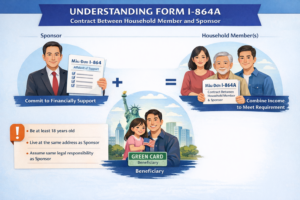For many people who are immigrating to the United States but waiting for a visa to become available, the Department of State (“DOS”) Visa Bulletin is the most important document to watch each month. The Visa Bulletin helps the applicants understand their place in line for a visa.
In most family immigration visa categories and all employment immigration visa categories, there are annual visa quotas of the number of people who can obtain an immigrant visa and move to the U.S. in each category.
When there is a higher demand for immigrant visas in a category than the number of visas available each year, these immigrant visas categories are referred to as “oversubscribed”. An applicant’s place in line for an oversubscribed visa is based on the date a petition for them is filed with the United States Immigrant and Citizenships Services (“USCIS”) and is called the Priority Date. The DOS updates the Priority Dates monthly and publishes them in the Visa Bulletin. The USCIS also uses the Visa Bulletin for applicants who are eligible to adjust their status in the United States.
The Visa Bulletin has two tables listing the Priority Date for each visa category and country of chargeability: (1) A “Final Action Dates” table (Table A); and (2) a “Dates for Filing” table (Table B).
What is “Final Action Date”?
Applicants with Priority Dates earlier than the date listed on the “Final Action Dates”, Table A, for their visa category and country of chargeability are now eligible to receive an immigrant visa. If they have not already done so, they should begin the visa application or file for adjustment of status.
What is “Dates for Filing Application”?
Applicants with Priority Dates earlier than the date listed on the “Dates for Filing”, Table B, for their immigrant visa category and country of chargeability are now eligible to begin the application process. They should be notified by the National Visa Center (“NVC”) that they are eligible to begin and asked to submit their documentation. However, an interview and final decision on the application cannot take place until the Priority Date is current on the Final Action Date (Table A).
For example, in the Visa Bulletin for April 2021, below, under the F4 category (Brothers and Sisters of U.S. citizens, All Chargeability Areas Except Those Listed), the Table B Dates for Filing Priority Date is 01OCT07 (October 1, 2007) while the Table A Final Action Date Priority Date is 01NOV06 (November 1, 2006). This means that applicants can begin their visa application process and submit their documentation if their Priority Date is on or before October 1, 2007, but they will still have to wait until their Priority Date on Table A becomes current before they can receive a visa.
Table A

Table B

See the April 2021 bulletin here.
The implementation of the Dates for Filing table was to create better efficiency for both applicants, who can begin to prepare their application in advance, and for better allocation of visas each month by the Department of State.
If you are in line waiting for a visa to become available, pay attention to the Table B, Dates for Filing to know when you can begin the application process, but understand you might still need to wait many more months before your visa number becomes available.
For more information about the visa bulletin, contact us at info@enterlinepartners.com and speak with a U.S. immigration lawyer in Ho Chi Minh City, Manila and Taipei.
ENTERLINE & PARTNERS CONSULTING
Ho Chi Minh City, Vietnam Office
Suite 601, 6th Floor, Saigon Tower
29 Le Duan Street
Ben Nghe Ward, District 1
Ho Chi Minh City, Vietnam
Tel: +84 933 301 488
Email: info@enterlinepartners.com
Facebook: Enterline & Partners – Dịch vụ Thị thực và Định cư Hoa Kỳ
Website: http://enterlinepartners.com
Manila, Philippines Office
Tel: +632 5310 1491
Email: info@enterlinepartners.com
Facebook: Enterline and Partners Philippines
Website: https://enterlinepartners.com/language/en/welcome/
Article last updated: 19th April 2021
Copyright 2021. This article is for information purposes only and does not constitute legal advice. This article may be changed with or without notice. The opinions expressed in this article are those of Enterline and Partners only.




